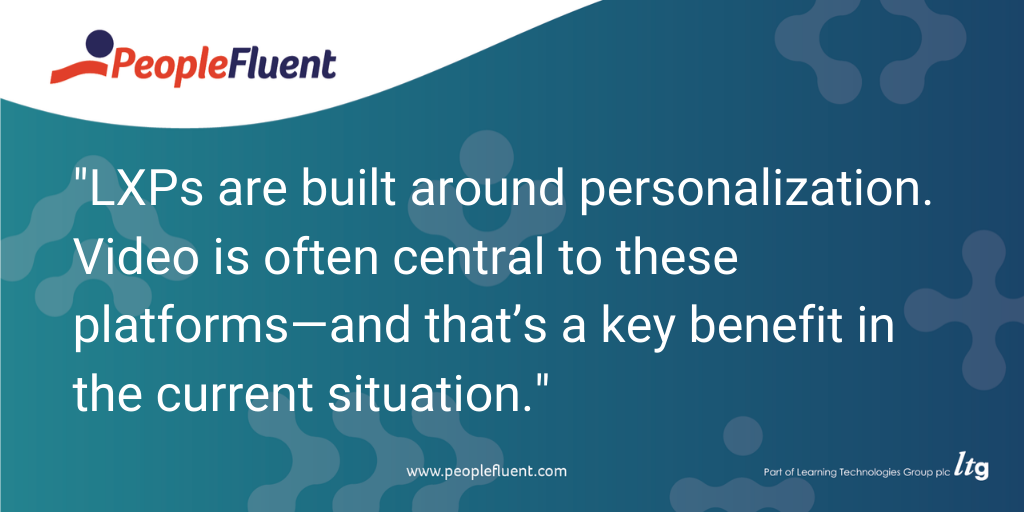Published: Mar 26, 2020Time to read: 7mins Category: Learning
4 Tips for Organizations Using Technology to Train Staff Now Working From Home
COVID-19 has forced an unprecedented and immediate shift towards remote working for a significant number of businesses around the world. With this situation likely to continue for some time, this article looks at how organizations are rising to the challenges that working from home brings—and how departments such as L&D can continue to train staff remotely.
As the US, Europe and the rest of the world proactively begin locking down places of work, remote working—previously an occasional perk for most—has become the only way that some businesses can continue to operate.
As a large section of the world’s workforce adjusts to a new life of working from home, employee training may find itself temporarily falling down the list of priorities. This would be a mistake: training has both a role in helping employees settle into their new working environments, and in continuing to deliver and maintain essential product knowledge and best practice.
Recommended related reading: 'The 13 Must-Have Features of a Learning Management
How Can eLearning Help Staff Settle Into Remote Working?
Remote working is nothing new. Across our teams in the US and UK, we have employees who work from home, alongside staff that (usually) work in offices. There are plenty of wise words already out there about the healthiest and most productive ways to work from home. Here’s some remote working advice that we like:
- Establishing a dedicated, ergonomic workspace that is removed as far as possible from the areas of the home in which you relax.
- Maintaining normal routines—if you usually wake up, shower, get dressed and have breakfast before work, you should maintain as many of these steps as possible.
- Finding time for exercise, eating well and staying hydrated.
- Drawing a definite line between your personal and private schedules and avoiding one bleeding into the other.
- Making an effort to be extra communicative—replacing those water-cooler chats with conversations on your messaging app of choice.
- Using video calls when you’re doing something that would usually involve a longer face-to-face conversation—visual cues in conversation are hugely important, and seeing other faces will help you feel less isolated.
Our colleagues at Watershed have recently published advice on this topic, advice that has been adapted by the team at Gomo into a piece of microlearning that their users can adapt for their own purposes.
Wherever you compile your working from home information from, distribute it and encourage managers to check up on and enforce its principles. Deploying work from home advice early through your eLearning environment isn’t just about getting the message out when it’s most relevant (though this is certainly the most important reason for doing so). It also clearly sends the message that it’s business as usual for L&D—and that training will continue despite the change in classroom surroundings.
More from the blog: "Powerful Remote Learning: No Internet? No Problem!"

4 Strategies for Remote Training
While it’s obvious that many organizations will have to take offline training online, it’s important to make sure this is done in a way that doesn’t sacrifice effectiveness. The advice on working from home above and elsewhere on the internet has some clear themes, especially: continuing to observe your usual routines, and using technology that bridges the interpersonal gaps now opened up.
This advice extends to how organizations need to approach remote training. As Training Industry puts it “Merely putting PowerPoint decks and other static materials online as a substitute for in-person will not suffice.”
1. Use Platforms That Personalize Learning
Studies have shown that the ideal learning scenario is a face-to-face, one-on-one, tutor/pupil interaction—a mode of learning that doesn’t exist for the vast majority even when classrooms are available.
A key benefit of one-on-one tutoring is personalization—something that Learning Experience Platforms (LXPs) are built around. By using adaptive learning technology that identifies the ways in which learners have already progressed, such platforms can identify resources that aid comprehension and refresh knowledge.
Video is often central to these platforms—and that’s a key benefit in the current situation. We have regularly recommended recording short video introductions to key learning content explaining its benefits and purpose. This is more important than ever in the absence of the at-desk catch ups that office workers would usually have.

2. Look for Opportunities to Make Training More Collaborative and Active
Corporate training is frequently an individual endeavor, even when work itself may be more collaborative. At the same time, distance learning tends to be more passive. Now that we’re facing a period of increased isolation, collaborative training and active training tactics will help increase engagement, reception and validation of learning.
Another Training Industry blog post ‘3 Keys to Successful Learning in the Remote Workplace’ outlines some ideas in this area. Firstly, it recommends interspersing activities between learning events using web conferences, chat rooms or forums. Secondly, it suggests designing a learning plan that “uses team-based learning goals and encourages and rewards collaboration”, pointing to the same mix of shared virtual spaces to help facilitate this.
Again, an LXP can help assist in pulling these different learning threads together, while facilitating comments and discussions on materials inline and in-context.
Also read: "3 Reasons Why Microlearning Should Be an Essential Part of Your Learning Strategy"
3. Convenience Is More Important Than Ever
In these COVID-19 times, we now find learning, living and working unexpectedly converging. We’d argue that this only heightens learner expectations that systems should be more like those they use at home. Learning tasks become less appealing the harder they are to find and start—whatever we can do to reduce time-to-resource in an environment that may have more distractions than usual, the better.
Our colleagues at LEO Learning have recently produced an insight piece tackling the transition from face-to-face to digital learning. In addition to lauding personalization, they come to a similar conclusion on convenience. They say: “Users expect to be able to find resources as easily as they would outside of work (i.e. Google).” They then point to learning resources “that are searchable, easily digestible and available at the moment of need” as particularly needed at this time.
4. Measure and Build Foundations For Future L&D Projects
The current coronavirus crisis has the potential to change working habits permanently. Some commentators are already suggesting that organizations may find it harder to resist larger-scale remote working arrangements. If the world’s workforce remains productive even in these uncertain times, old narratives that prevent the wider adoption of remote working will be challenged.
Even if the working world was to defy these predictions, L&D will have the opportunity to make things better for the remote workers they already serve. The worst thing we can all do is to forget these best practices we’re now learning in work and training. Better still, let’s learn from implementing them—we can put learning analytics to work and build the best learning programs possible for remote workers.
A version of this post originally appeared on the Instilled blog.
Discover How Learning Builds Skills and Ensures Compliance
Design, deploy, track, analyze, and report on enterprise learning and compliance programs. PeopleFluent helps you execute your programs seamlessly, so employees upgrade their skills and you get results.